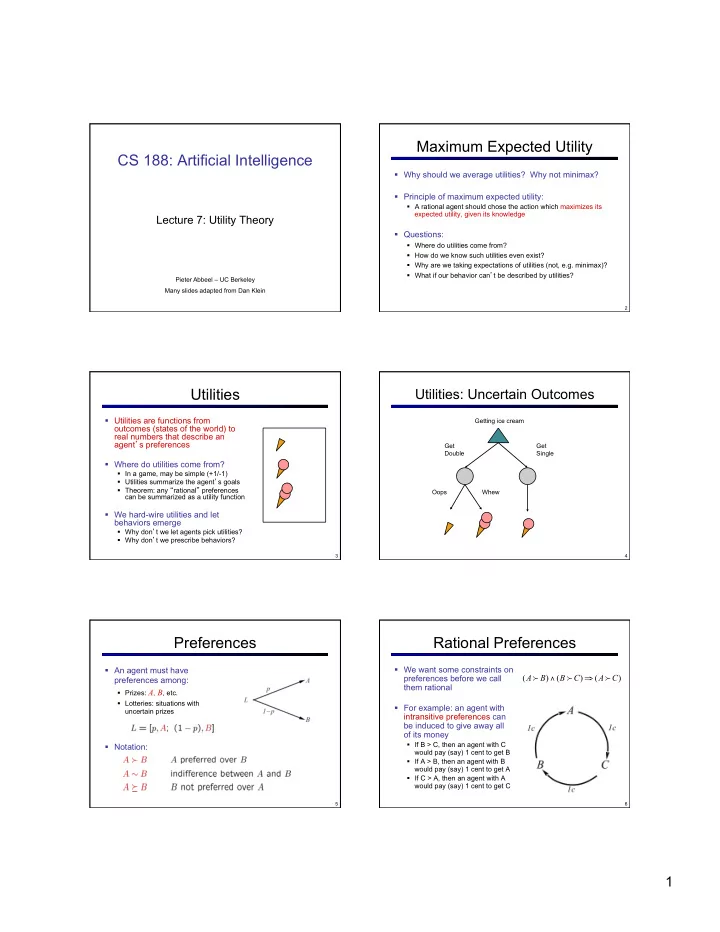

Maximum Expected Utility CS 188: Artificial Intelligence § Why should we average utilities? Why not minimax? § Principle of maximum expected utility: § A rational agent should chose the action which maximizes its expected utility, given its knowledge Lecture 7: Utility Theory § Questions: § Where do utilities come from? § How do we know such utilities even exist? § Why are we taking expectations of utilities (not, e.g. minimax)? § What if our behavior can ’ t be described by utilities? Pieter Abbeel – UC Berkeley Many slides adapted from Dan Klein 1 2 Utilities Utilities: Uncertain Outcomes § Utilities are functions from Getting ice cream outcomes (states of the world) to real numbers that describe an agent ’ s preferences Get Get Double Single § Where do utilities come from? § In a game, may be simple (+1/-1) § Utilities summarize the agent ’ s goals § Theorem: any “ rational ” preferences Oops Whew can be summarized as a utility function § We hard-wire utilities and let behaviors emerge § Why don ’ t we let agents pick utilities? § Why don ’ t we prescribe behaviors? 3 4 Preferences Rational Preferences § An agent must have § We want some constraints on ( A B ) ( B C ) ( A C ) preferences before we call ∧ ⇒ preferences among: them rational § Prizes: A, B , etc. § Lotteries: situations with § For example: an agent with uncertain prizes intransitive preferences can be induced to give away all of its money § If B > C, then an agent with C § Notation: would pay (say) 1 cent to get B § If A > B, then an agent with B would pay (say) 1 cent to get A § If C > A, then an agent with A would pay (say) 1 cent to get C 5 6 1
Rational Preferences MEU Principle § Preferences of a rational agent must obey constraints. § Theorem: § The axioms of rationality: § [Ramsey, 1931; von Neumann & Morgenstern, 1944] § Given any preferences satisfying these constraints, there exists a real-valued function U such that: § Maximum expected utility (MEU) principle: § Choose the action that maximizes expected utility § Note: an agent can be entirely rational (consistent with MEU) without ever representing or manipulating utilities and probabilities § Theorem: Rational preferences imply behavior § E.g., a lookup table for perfect tictactoe, reflex vacuum cleaner describable as maximization of expected utility 7 8 Utility Scales Human Utilities § Normalized utilities: u + = 1.0, u - = 0.0 § Utilities map states to real numbers. Which numbers? § Standard approach to assessment of human utilities: § Micromorts: one-millionth chance of death, useful for paying to reduce product risks, etc. § Compare a state A to a standard lottery L p between § “ best possible prize ” u + with probability p § QALYs: quality-adjusted life years, useful for medical decisions § “ worst possible catastrophe ” u - with probability 1-p involving substantial risk § Adjust lottery probability p until A ~ L p § Note: behavior is invariant under positive linear transformation § Resulting p is a utility in [0,1] § With deterministic prizes only (no lottery choices), only ordinal utility can be determined, i.e., total order on prizes 9 10 Money Example: Insurance § Money does not behave as a utility function, but we can talk about § Consider the lottery [0.5,$1000; 0.5,$0] the utility of having money (or being in debt) § What is its expected monetary value? ($500) § Given a lottery L = [p, $X; (1-p), $Y] § The expected monetary value EMV(L) is p*X + (1-p)*Y § What is its certainty equivalent? § U(L) = p*U($X) + (1-p)*U($Y) § Monetary value acceptable in lieu of lottery § Typically, U(L) < U( EMV(L) ): why? § $400 for most people § In this sense, people are risk-averse § Difference of $100 is the insurance premium § When deep in debt, we are risk-prone § There ’ s an insurance industry because people will pay to reduce their risk § Utility curve: for what probability p § If everyone were risk-neutral, no insurance needed! am I indifferent between: § Some sure outcome x § A lottery [p,$M; (1-p),$0], M large 11 12 2
Example: Human Rationality? § Famous example of Allais (1953) § A: [0.8,$4k; 0.2,$0] § B: [1.0,$3k; 0.0,$0] § C: [0.2,$4k; 0.8,$0] § D: [0.25,$3k; 0.75,$0] § Most people prefer B > A, C > D § But if U($0) = 0, then § B > A ⇒ U($3k) > 0.8 U($4k) § C > D ⇒ 0.8 U($4k) > U($3k) 13 3
Recommend
More recommend